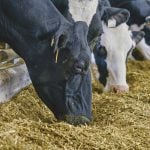It is unfortunate, but the legislation intended to protect wildlife and wildlife habitat is making it increasingly difficult for the ranching industry to operate in the same way as previous generations.
Unfortunately, most of this legislation is counterproductive; not only is there little concrete evidence showing this type legislation is saving any species from the brink of extinction, but this type of legislation is generating a great deal of fear and mistrust in the ranching industry.
In fact, one could argue much of the environmental legislation has encouraged many ranchers to regard the presence of endangered species, and wildlife in general, on their property as a liability. If ranchers are to regard wildlife as an asset, they must view wildlife in a positive manner.
Read Also

Machinery automation runs through 2025 Agritechnica innovation awards
Computer vision and AI processing for farm machinery show up many times in Agritechnica’s 2025 innovation award winners.
Need incentives
The easiest way to accomplish this goal is to give ranchers an economic incentive by paying them to manage wildlife habitat. For this strategy to be effective, determining the level of payment and the payment mechanism would depend upon finding a method to determine the economic value of wildlife and wildlife habitat. At the same time, ranchers must be able to show the other stakeholders (government agencies, environmental groups, and non-governmental organizations) they have the skills to deliver the product.
The concept of free-market environmentalism offers a plausible alternative to government intervention. However, for free-market environmentalism to work, it is important to assign an economic value to the goods and services associated with biodiversity.
While it can be relatively easy to determine the economic losses incurred by wildlife depredation or even predict the potential economic gain from activities such as hunting, it can be very difficult to determine the economic benefits of species with little or no apparent economic value (such as endangered species).
Ironically, there is very little connection between the compensation a rancher receives and the actual economic value of the goods and services provided by biodiversity. More often than not, it is the economic value of the land or the economic losses a rancher would incur by relinquishing an economic opportunity, such as selling to a land developer or converting native grass into cropland, that determines the level of compensation a rancher receives. One of the first goals of any program designed to conserve biodiversity would be to develop economic models that reflect the true economic value and costs of biodiversity.
Who compensates?
Even if it were possible to determine the absolute economic value of biodiversity, the next task becomes one of determining who will compensate the rancher. Until now, no one has given a definitive answer to this question. Unfortunately, funding for this endeavour would come from those groups most ranchers instinctively mistrust: government agencies and environmental groups. Therefore, for free-market environmentalism to be effective the ranching community must begin working with these groups in a positive manner.
Even if ranchers were to come terms with taking money from environmental groups or government agencies, this money would come with strings attached. Any group willing to hand over a large amount of money to a producer will want have in place certain mechanisms that ensure the rancher is meeting specific ecological goals.
Essentially this will involve a process allowing a third party to complete an initial survey to determine the initial ecological condition of the ranch, followed up by regular “inspection” surveys to determine if the rancher is upholding his end of the bargain. If the rancher’s management practices do not produce the expected results, the group forking over the money may begin pressuring the rancher to alter his management practices.
Either way the rancher must contend with the idea of having his management practices scrutinized by someone else. As a result, the rancher must be able combine diplomacy and science to explain his management practices to those groups paying him.
Governments enact legislation in response to pressure from the public to preserve endangered species and endangered species habitat. Therefore, ranchers are finding it more difficult to manage their ranches as in previous generations. An alternative is to adopt legislation encouraging free-market environmentalism to guide resource management, thereby making it possible to compensate ranchers for their management skills.
A few conditions
However, for free-market environmentalism to work, a number of conditions must be met:
1) the ranching industry must be willing to sit down with the other stakeholders to create economic models that reflect the real economic value of biodiversity,
2) in return for compensation they must be willing to meet certain management standards.
In addition, ranchers must realize the economic models they create may have some serious drawbacks that include:
1) it is difficult to test the economic model’s assumptions,
2) finding sufficient funds to make the project worthwhile and
3) having a third party question the rancher’s management decisions.
If ranchers are willing to deal with these issues in a constructive manner, free market environmentalism is a better option for the management of resources than the current policy of creating restrictive legislation. †














